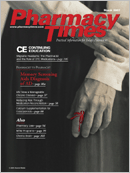PDAs Help Pharmacists Deliver The Best Care, Anywhere
Pharmacists are busier than evertoday, and they need to stay ontop of the latest technologicaladvances in order to keep up withincreasing patient demands. One ofthese advances is the ability to trackpatients' medical information onlinefrom any location using personal digitalassistants (PDAs). This capability isessential when dealing with high-riskpatients, when medication changesmay need to occur quickly at any time.
Thomson Healthcare (GreenwoodVillage, Colo) has set out to meet theneeds of the modern pharmacist withinnovative software solutions. WilliamLawson, MD, vice president ofclient solutions, discussed thebenefits of working with ThomsonHealthcare.
"The technologies and solutionsthat we provide to hospital pharmaciesare just as valuable in theretail setting," Dr. Lawson said. "Inthe hospital, we provide detaileddrug information, drug-interactionalerts and tools, patient-educationinformation, mobile/PDA access toall our referential content, andeven pill-identification tools."
"These same solutions are beingintroduced to the retail pharmacist?with the same goal of providing thebest evidence-based clinical informationat the point of care," he added."The goal is to automate repetitivemanual processes and free upthe?pharmacist to be more of ahands-on clinician and less of a bookkeeper."
One of Thomson Healthcare's newestadvances is the Medication ReconciliationSolution, a Web-basedinterface that simplifies the process ofcollecting and monitoring patients' medication lists from the time they areadmitted until they are discharged. Thesystem integrates data from local communitypharmacies, insurance companies,and previous hospital visits tocompile a comprehensive list of apatient's current medication profile.
At each stage of a patient's treatment,caregivers can choose to continue,discontinue, or modify the dosagesof current medications or add othermedications by way of a visual reconciliationprocess. When the patient is discharged,medication orders can be sentdirectly to the patient's home pharmacyand to his or her primary careprovider.
The Medication Reconciliation Solutionhelps manage a patient's medicationlist through a number of features.The system keeps an electronic list ofthe patient's current home medicationsand automatically checks for allergies,duplications, interactions, and warningswhen new medications are ordered. If apatient does not know the name of hisor her medicine but can describe it, thesystem has a drug-identification toolthat provides images, descriptions, andimprint codes to aid in establishing theidentity of mystery drugs. The applicationis linked directly to comprehensiveevidence-based drug information fromThomson Healthcare.
The Pharmacy Interventions Solutionfrom Thomson Healthcare applies technologyto allow the hospital pharmacistto automatically identify at-risk patientsmost in need of interventions and thenputs all clinical data within the pharmacist'sreach at the point of care. It providesthe pharmacist with desktop andhandheld access to up-to-date patientdata (medications, demographics, laboratoryresults, and reports) and to clinicalreference data. In addition, it offersa tracking tool for monitoring theprogress and results of all the interventionsinitiated by the pharmacy.
The Formulary Advisor Solutioneliminates the need to enter formularyupdates manually. Everythingis done online, so that theformulary manager can spend lesstime administering and communicatingchanges. The pharmacist onrounds can get online and handheldPDA access to the up-to-dateformulary with links back into theDRUGDEX System (a ThomsonHealthcare referential contentproduct) for more detailed information.Pharmacists who use theFormulary Advisor show less timespent on administration and confirmingwhich drugs are or are not on the formularyand, ultimately, more time spentwith patients?resulting in betterpatient care.
Another company that is working tohelp pharmacists help their patientsbetter is Lexi-Comp Inc. Based inHudson, Ohio, the company was foundedto create custom reference handbooksfor clinical laboratories. It hassince expanded its content base andtechnology solutions to provide real-time information at the point of care inknowledge areas that include pharmacology,interactions, diagnostic proceduresand laboratory tests, pharmacogenomics,poisoning and toxicology,dentistry, infectious diseases, and patienteducation.
Information is delivered on a varietyof electronic platforms. They includeLexi-Comp ON-LINE, ON-HAND, ONDESKTOP,and ON-WEB. All of theseplatforms can be integrated for hospitalsand health systems through theLexi-Comp Knowledge Solution.
"Lexi-Comp ON-LINE uniquely integratesindustry-leading databases andenhanced searching technology todeliver time-sensitive clinical informationat the point of care," said DanielKrinsky, MS, RPh, Lexi-Comp's directorof corporate training and development."The interface eliminates the need tonavigate through multiple pages ormake unnecessary mouse clicks."
Lexi-Comp ON-LINE provides accessto drug-information databases, an interactions-analysis application, patientadvisory leaflets for drugs and diseasestates, a drug-identification program, amedical-calculations module, and manyother features.
Lexi-Comp ON-HAND delivers verysimilar content to what is offeredonline, but through various mobiledevices with Palm OS, Pocket PC, andBlackBerry operating systems.
The company's most comprehensivedrug database is Lexi-Drugs, an easy-touserecord of more than 1600 drugmonographs supporting over 8000 USand Canadian medications. Its contentaddresses many patient populationsand clinical specialties such as pharmacy,internal medicine, cardiology, oncology,psychiatry, and anesthesiology. Themonographs provide up to 55 fields ofinformation, among them adverse reactions,US and Canadian brand names,contraindications, dosing, special alerts(including new FDA warnings), medication-safety issues, pharmacodynamics/kinetics, and brand names from >75countries.
Another key database is Lexi-Interact, a tool for checking patient profilesfor drug, food, herbal, and alcoholinteractions. This program performs ananalysis of a patient's entire drug andnatural-product profile to identifypotential interactions. Fully referencedand evidence-based, this applicationfacilitates a patient-specific risk-to-benefitassessment. Analysis results offer adetailed overview of the interactions,with fields such as risk rating, patientmanagement, class exceptions, discussion,and references.
Lexi-Comp ON-DESKTOP is a comprehensivecollection of the company'smedical-reference databases and integratedmodules. Shipped to subscriberson a single CD-ROM for Microsoft Windowsor Mac OS, ON-DESKTOP providesinstant access to >70,000 pages of currentclinical information in a conciseand easy-to-read format. Users pointand click to find answers regardingdiagnosis, treatment, and other clinicaldecisions.
A subscription to ON-DESKTOP includes1-click updates through theInternet during the subscription period.The benefit of this platform is thataccess does not require continuousInternet connectivity; users can downloadupdates when connectivity isavailable. This is an ideal solution forconsultant pharmacists and those whouse a laptop with inconsistent Internetaccess.
Lexi-Comp provides daily updates toits drug monographs through continuouspeer review that includes consultantsand reviewers from client hospitals,135 outside authors, and an onstaffteam of pharmacists. TheKnowledge and Academic Solutions areused at hundreds of institutions, andthe ON-HAND software is utilized bythousands of clinicians throughout theworld. Lexi-Comp also publishes a comprehensivehandbook library of morethan 40 reference titles, including theDrug Information Handbook, thePediatric Dosage Handbook, and theGeriatric Dosage Handbook.
Both Thomson Healthcare and Lexi-Comp are dedicated to providing pharmacistswith the newest software tohelp them stay abreast of all the medicationrequirements of their patients.With the aid of modern medicationinformationsystems, pharmacists cankeep up with their patients' needs asquickly as they arise.

